Sign up. Be inspired. Get clicking.
Train tourism carbon savings compared to flights
28 April 2025
Air travel is a major contributor to global emissions, accounting for approximately 2–4% of worldwide CO₂ output. In addition to direct emissions, flights at high altitudes have further atmospheric effects that amplify their impact. For travellers seeking lower-impact options, alternative modes of transport can make a substantial difference.
Research shows that rail travel can reduce emissions by 73–91% on many popular routes. For instance, a Eurostar study found that a journey from London to Paris by train produces around 22kg of CO₂, compared with 244kg by plane. Similar patterns are seen across Europe, highlighting rail as a significantly cleaner choice.
This guide outlines practical ways to reduce your environmental footprint, comparing time, cost, and emissions across different travel options. Data from trusted sources such as DEFRA and the IPCC supports these findings.
Choosing more thoughtful ways to travel not only lowers emissions but also allows you to explore new destinations without compromising on comfort or convenience. Rail travel, in particular, offers a straightforward and much less polluting alternative.

Why choosing trains over flights helps the planet?
Emissions released at high altitudes significantly intensify aviation’s contribution to global warming. Although flights are responsible for around 4% of human-induced temperature rise, their overall impact is heightened by atmospheric conditions.
Aircraft produce approximately 285g of CO₂ per passenger-kilometre—over seven times more than the average for UK trains at 41g. Eurostar services achieve even greater efficiencies, with emissions as low as 6g per passenger-kilometre, thanks to electrified tracks and highly efficient operations.
Altitude plays a crucial role. Emissions released at cruising height cause between 1.27 and 2.5 times more warming than ground-level CO₂, a phenomenon known as the “radiative forcing” effect, as highlighted by research from the University of Leicester.
Luxury air travel increases the burden further. Business class seats produce roughly three to four times the emissions of economy class, while private jets, often favoured by celebrities, generate even higher per-passenger CO₂ output.
Choosing rail over air travel avoids a large share of these emissions. France’s predominantly nuclear-powered rail network demonstrates how clean energy can substantially reduce travel-related impacts. If just 10% of UK domestic flights shifted to train services, around 410,000 tonnes of CO₂ could be saved each year.
With air passenger numbers expected to reach 8.2 billion by 2037, changing how we travel is essential. Rail offers a proven and effective way to ease aviation’s strain on the environment.
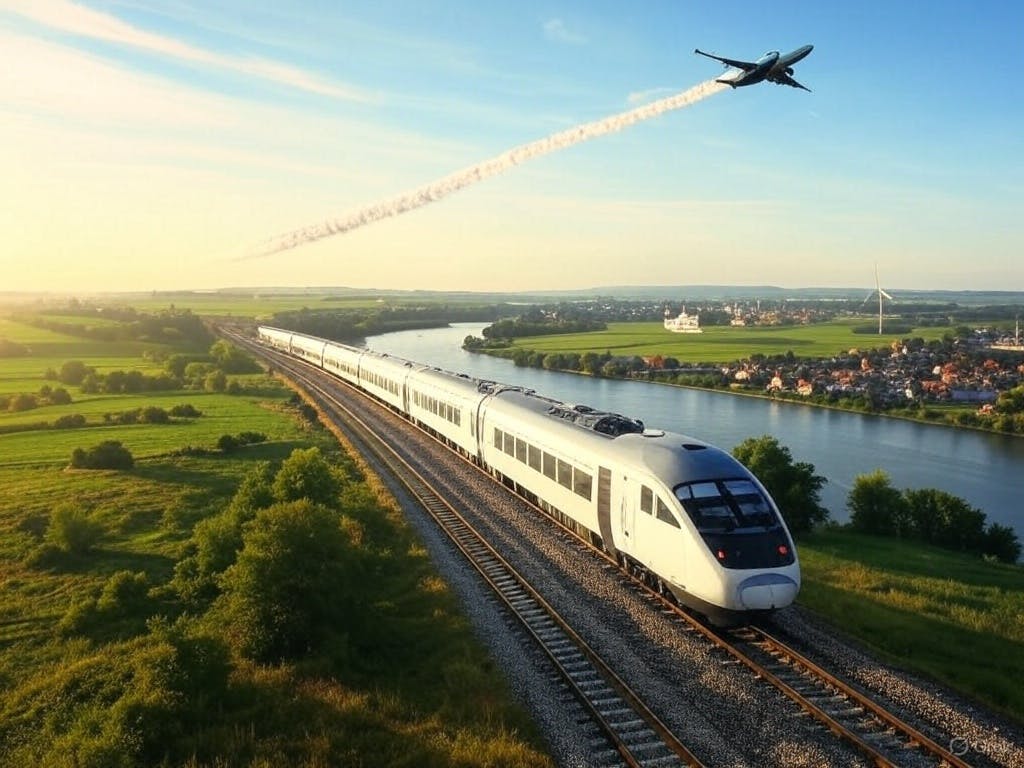
Train tourism carbon savings compared to flights: by the numbers
Figures clearly show how much less polluting rail travel is compared to flying. A journey from London to Nice generates just 36kg of CO₂ by train, compared to 250kg by air. Even on longer trips, such as London to Tangier, taking a 48-hour rail and ferry combination can reduce emissions by up to 85%.
Specific examples highlight the difference:
- Paris: 91% lower emissions per passenger
- Edinburgh: 89% reduction
- Nice: 85% lower emissions
Accurate measurement methods are essential. DEFRA’s centre-to-centre calculations include ferry connections where applicable, while Ecopassenger.org cross-verifies figures using real-time electricity grid data. Sleeper trains also remain a highly efficient choice, even when operating below full capacity.
Electric trains emit around 45g of CO₂ per passenger-kilometre—roughly half the emissions of diesel-powered trains. France’s extensive use of nuclear energy on its rail network helps reduce emissions even further. In contrast, cruise ships produce approximately 251g of CO₂-equivalent per berth-kilometre, highlighting their significantly higher impact.
Energy sources do influence outcomes. Rail services operating on coal-based grids will see higher emissions, yet even in such cases, trains typically produce less CO₂ than planes on most routes.
Beyond CO₂: other environmental benefits of train travel
Rail systems offer advantages beyond lower CO₂ emissions. Compared to road transport, they reduce air pollutants such as nitrogen oxides (NOₓ) by around 50% and cut particulate matter by up to 90%.
Noise pollution is also significantly lower. Trains typically operate between 50 and 75 decibels, whereas aircraft noise can reach between 85 and 105 decibels, easing the burden on communities near railway lines and airports alike.
Rail is far more efficient in terms of land use. Railway infrastructure requires roughly one-third of the space needed for highways, helping to limit urban sprawl and reducing the fragmentation of wildlife habitats.
Energy efficiency is another key strength. Trains consume around 0.15 kWh per passenger-kilometre—around four times less than planes at 0.63 kWh. Electric trains further improve efficiency through technologies like regenerative braking.
Durability also sets rail apart. Tracks and rolling stock can serve for more than 50 years, compared to an aircraft’s typical lifespan of 15 to 20 years. In addition, around 97% of train components are recyclable, cutting down waste significantly.
Rail travel also benefits water quality. Unlike aviation, it avoids the use of de-icing chemicals that can seep into groundwater, and reducing the need for airport expansions helps cool urban heat islands.
An EU study found that rail’s external costs—including noise, accidents, and pollution—are eight times lower than those of aviation. Together, these advantages make rail a stronger choice for both communities and the climate.
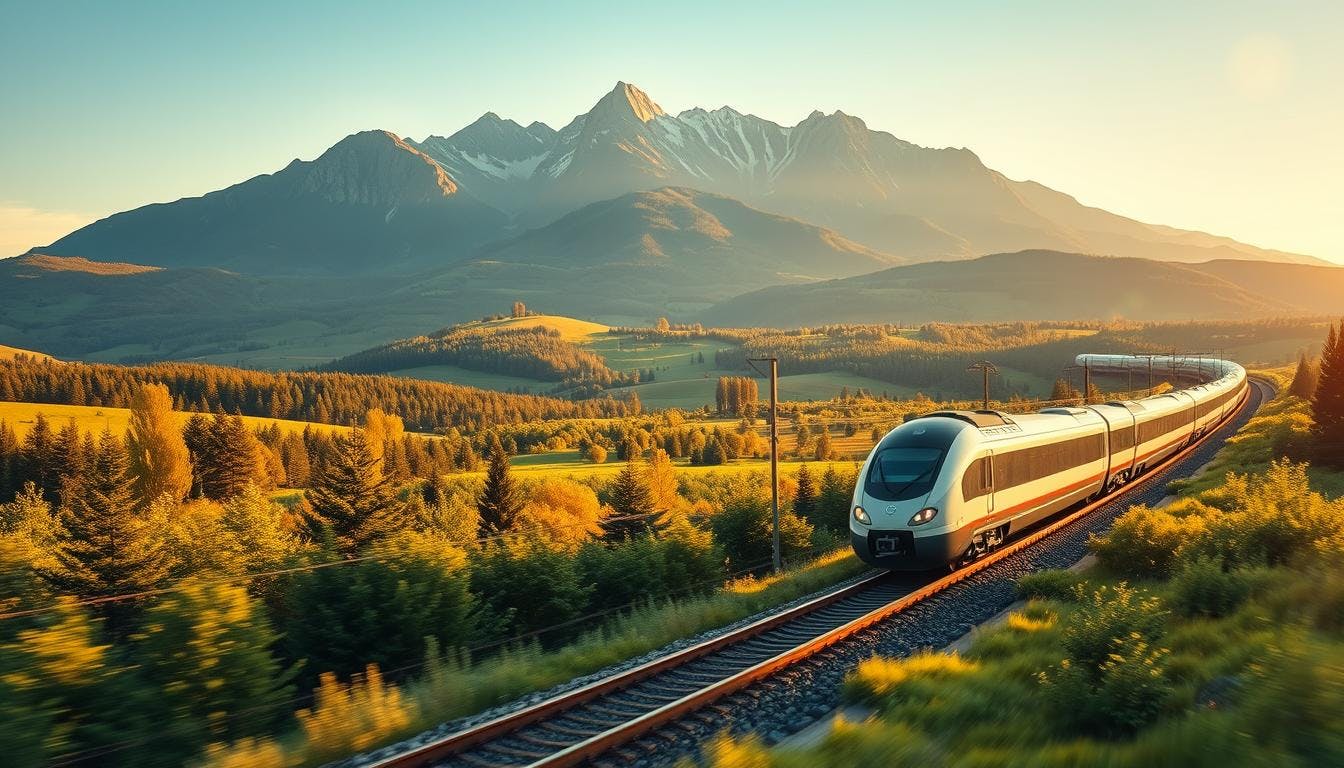
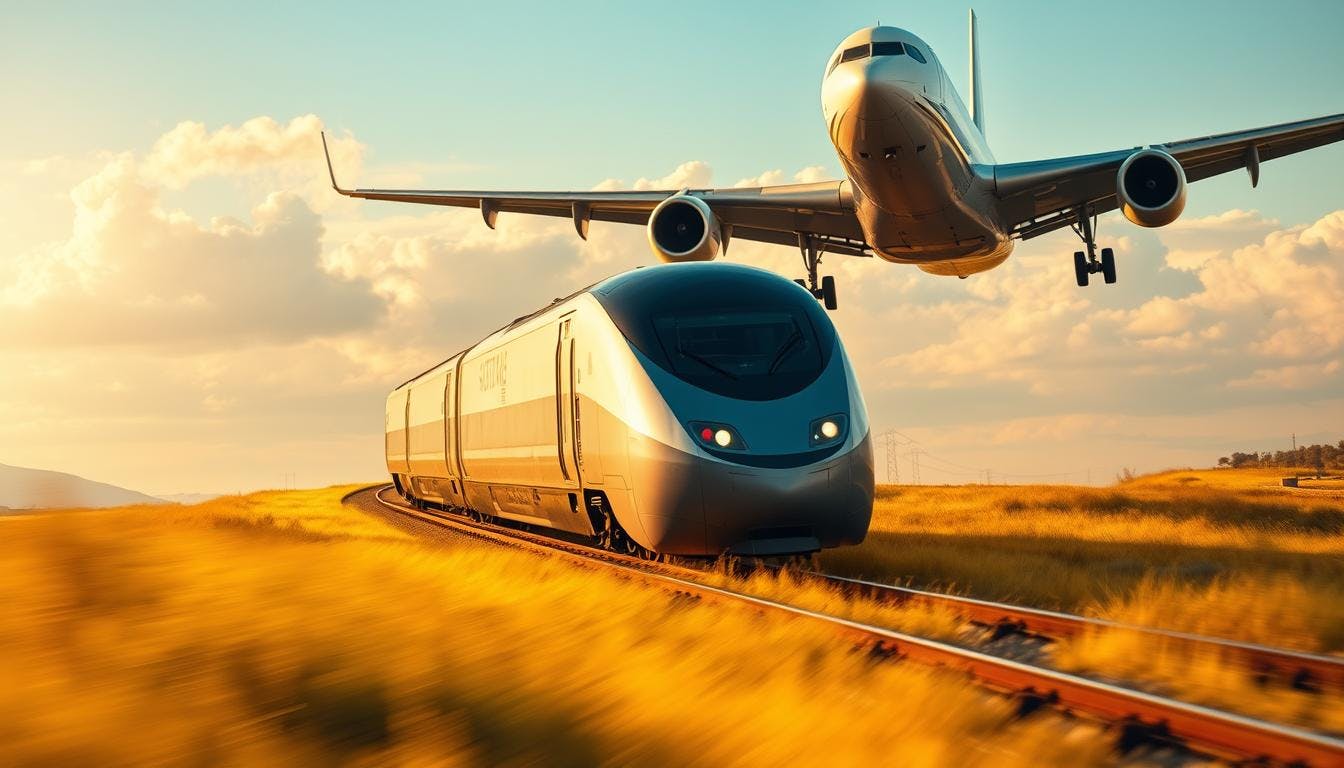
Time and convenience: debunking the faster flight myth
When considering door-to-door travel times, rail often comes out ahead, especially when airport procedures are factored in. A journey from London to Paris takes 2 hours 45 minutes by train, compared to 3 hours 30 minutes by plane, including transfers. Security checks, boarding, and other airport procedures can easily add over 2 hours to air travel time.
Rail stations are usually located in city centres, eliminating the need for time-consuming commutes from peripheral airports. According to Chronotrain's maps, over 50 cities across the EU are accessible within 8 hours by rail. High-speed trains, travelling at speeds between 250 and 320 km/h, help bridge the gap between travel times.
On trains, productivity often improves. With reliable Wi-Fi and spacious work areas, trains offer a more comfortable working environment than cramped plane seats with minimal desk space. Train travel also comes with simpler baggage policies, avoiding additional fees and restrictions commonly found in air travel.
Single-mode travel also reduces stress. The University of Amsterdam’s research confirms that rail offers a more relaxing journey. For trips under 4 hours, rail often wins in terms of total time, comfort, and the overall travel experience.
How to calculate your personal travel emissions
Understanding the environmental impact of your travel starts with accurate emissions calculations. Tools like EcoPassenger.org help compare CO₂ emissions per passenger across different routes. For example, ferries emit 22.54g of CO₂ per kilometre, while short-haul flights release 285g.
To get precise results, use DEFRA’s 2023 conversion factors. For instance, a journey from London to Amsterdam emits 36kg of CO₂ by train, compared to 250kg by air. Various factors, such as the type of aircraft and the energy mix powering the rail network, influence these outcomes.
Key factors to consider include:
- Load factors: Fully occupied trains or planes spread emissions more efficiently across passengers.
- Electricity sources: Rail networks powered by nuclear energy can reduce CO₂ emissions further.
- Ferry segments: Don’t forget to include these when calculating emissions for multi-modal journeys.
Offset programmes have limitations. Up to 30% of the fees may be allocated to administrative costs, rather than direct emission reductions. DEFRA’s air-to-rail ratio (10:1) illustrates the significant gap between air and rail travel in terms of emissions.
For businesses, the Climate Action Accelerator’s toolkit offers a way to track travel-related emissions. Coaches are another low-impact option, emitting just 27g of CO₂ per kilometre. Always verify emissions claims to avoid misleading or exaggerated assertions.

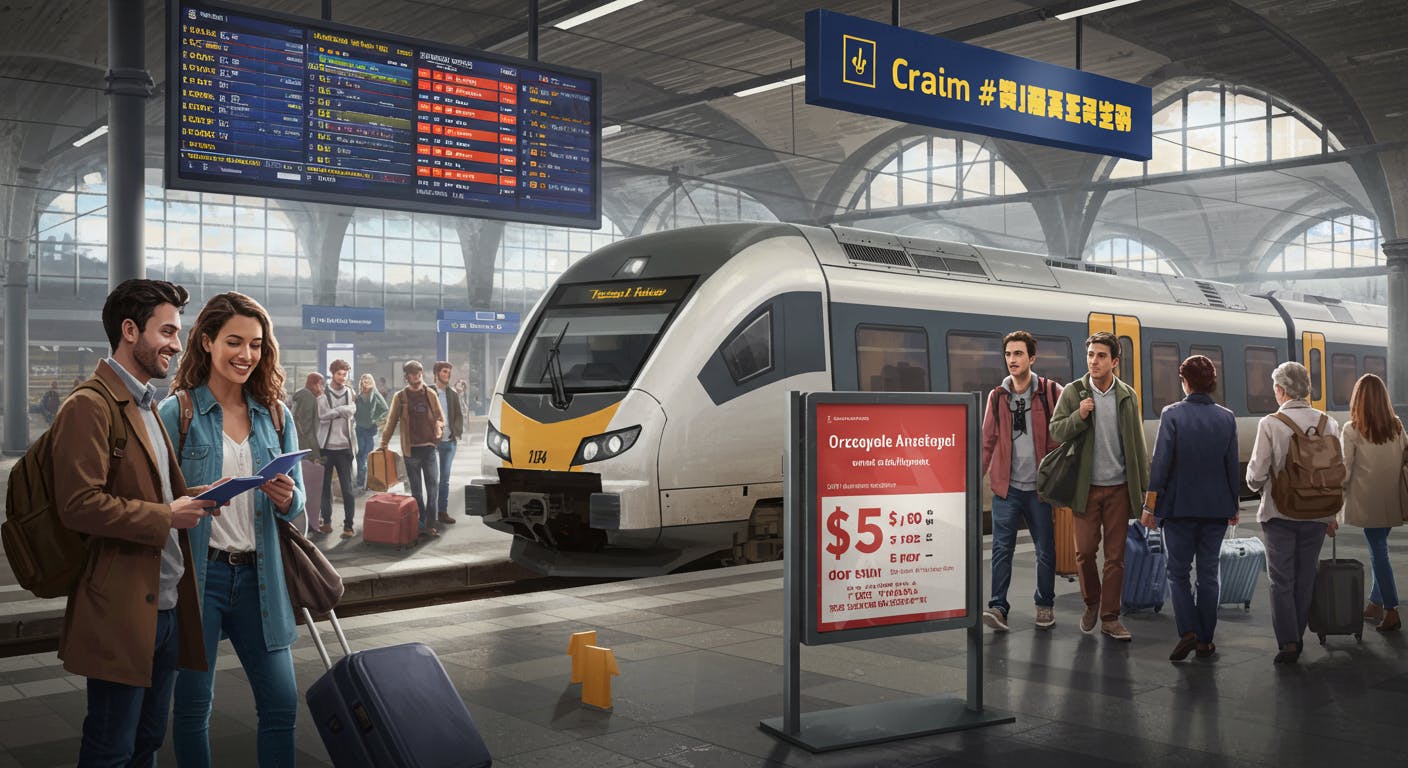
The truth about cost: are trains really more expensive?
Many travellers assume rail travel is more expensive, but the data tells a different story. A 2023 Greenpeace study of 112 European routes found that 71% of journeys were cheaper by train when booked one month in advance. Airlines often obscure the true cost of travel with dynamic pricing and hidden fees.
Booking in advance can significantly reduce rail fares. For example, France’s TGV offers discounts of up to 70% for early bookings. Fixed pricing structures also make rail travel more predictable, unlike the fluctuating prices of airlines, which often spike closer to departure.
Additional flight costs quickly add up. Baggage fees, airport transfers, and overnight hotel stays can substantially increase the overall price of air travel. By contrast, night trains double as accommodation, saving passengers over $100 per trip.
For businesses, SNCF’s corporate discounts can reduce costs by up to 25%.
There is also a notable subsidy gap. EU aviation receives €34 billion in tax breaks, which is three times the €12 billion allocated to rail.
To compare prices across different modes of transport, tools like Omio.com are useful for finding the best options.
Railcards provide further savings. In the UK, passengers can receive up to a third off fares with regional passes. When factoring in the total cost of a trip—including meals, seating, and Wi-Fi—rail often offers better value than budget airlines, whose fares can be stripped down to the basics.
Step-by-step: planning a low-carbon train journey
Planning a sustainable journey starts with smart route selection. Night trains connect 34 European cities, with popular routes reaching 90% occupancy. Follow these steps to book efficiently and reduce emissions.
Map your route: Use RailEurope.com for multi-country tickets. Opt for direct routes to minimise transfers.
Time your booking: Eurostar tickets are released 120 days in advance. For Interrail passes, book early to access discounts.
Choose seating: Sleeper cabins cost more but replace hotel stays, while couchettes offer budget-friendly privacy.
Verify policies: Operators like SNCF allow bikes, while others may require disassembly. Check luggage limits for each service.
Track carbon: Use SNCF’s emissions calculator to estimate the environmental impact of your journey and compare it to flight equivalents.
Finalise details: Download apps such as DB Navigator and Trainline for live updates and e-tickets.
Pro tips for smoother trips:
- Avoid split-ticketing scams—some third-party websites inflate prices.
- EU Railtours packages bundle scenic routes with hotels for a seamless experience.
- Electric routes, such as France’s TGV, further reduce emissions.
With careful planning, rail travel becomes both affordable and sustainable. Early bookings ensure the best rates and seat availability.

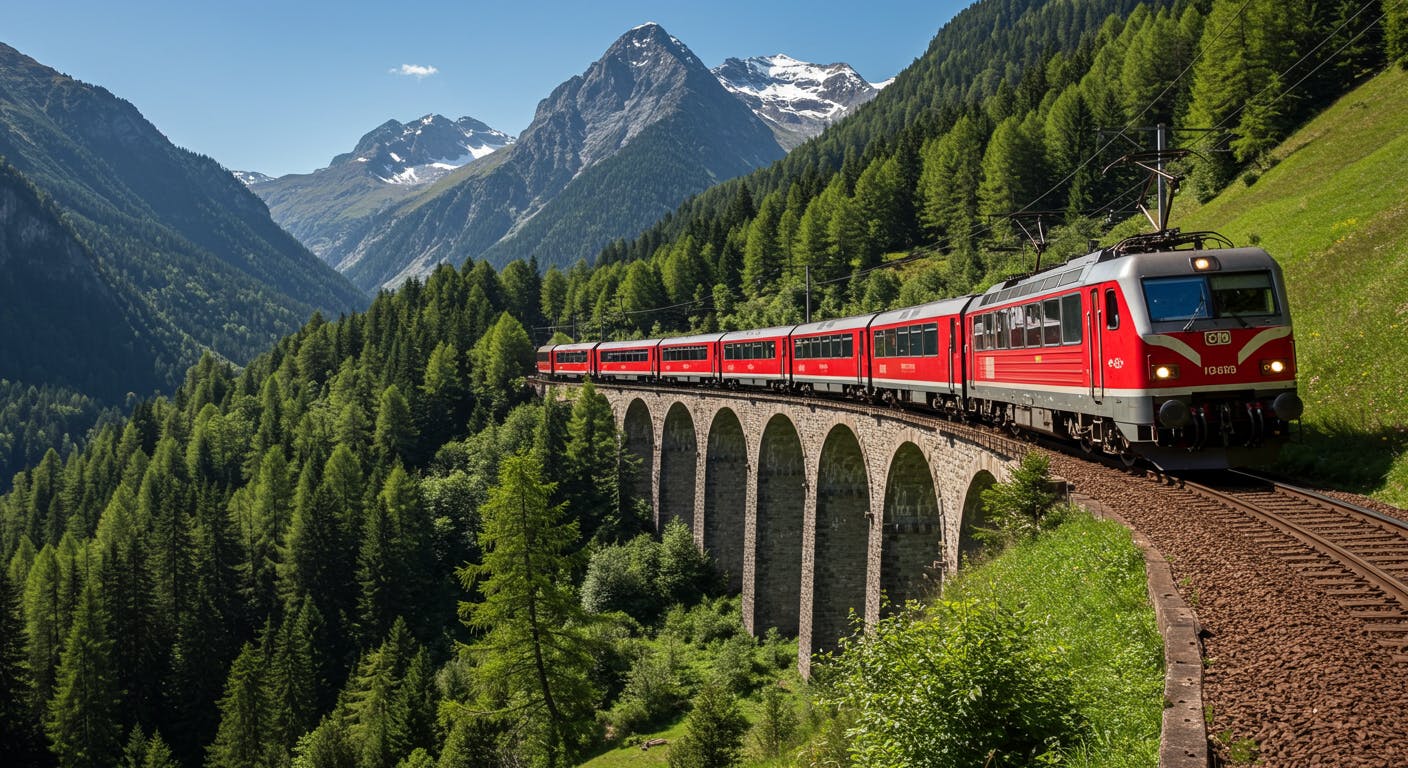
Night trains and scenic routes: making the journey part of the adventure
Iconic routes such as the Glacier Express show that adventure and sustainability can go hand in hand. This Swiss marvel emits 92% less CO2 than flights between Zurich and Zermatt, combining scenic travel with minimal environmental impact.
Bergen Line (Norway): This route crosses mountain plateaus, emitting just 11kg of CO2 compared to 89kg by air.
Trans-Siberian Railway: Spanning 9,289km, this route offers sleeper cabins, cutting emissions from hotel stays.
Bernina Express: Connecting Milan to St. Moritz, this route features UNESCO-listed viaducts.
Semmeringbahn (Austria): A pioneering example of 19th-century alpine engineering.
Darjeeling Himalayan Railway: A narrow-gauge track running through scenic tea plantations.
Slow travel enriches the experience. Night trains, like ÖBB’s Nightjet network, combine transport with accommodation. A journey from Vienna to Rome, for example, saves 120kg of CO2 compared to flying.
Back-on-Track.eu tracks 34 European night routes, offering a range of options. Deluxe cabins come with private showers, while couchettes provide affordable privacy. For compact sleeping spaces, packing light is essential.
Dining cars offer regional dishes, but packed meals can help reduce costs. For photography enthusiasts, here are a few tips:
- Use polarising filters for glacier views.
- Book westward-facing seats for sunset panoramas.
- Capture motion blur with a 1/125s shutter speed.
Multi-destination tickets, such as the Eurail Pass, allow you to explore hidden stops across 33 countries, supporting community tourism. Local guides at rural stations can add depth to your journey.
What governments and businesses can do to promote rail travel
Policy changes can significantly accelerate the transition to more sustainable transport. France’s ban on short-haul flights where rail alternatives are available led to a 12% reduction in domestic aviation. Similar measures could be adopted globally.
Tax reforms could help level the playing field between rail and air travel. Aviation fuel currently benefits from a €0.33/litre tax exemption, while diesel is taxed at €1.80. Aligning these taxes could provide the funds needed for rail infrastructure improvements.
Businesses also play a key role. Lufthansa’s Rail&Fly programme integrates train tickets with flight bookings, making rail travel more convenient. Corporate policies, such as the "4-hour train rule," prioritise rail for short journeys.
The EU’s Fit for 55 package includes measures targeting transport emissions. In Germany, the introduction of a €49 monthly rail pass resulted in a 21% increase in ridership. Night trains, such as ÖBB’s Vienna-Hamburg route, now capture 30% of the market share.
Investments in hydrogen trains and VAT exemptions for international tickets would further tip the scales in favour of rail. Trials by Siemens Mobility show that zero-emission technology is already viable.
Advocacy groups like Stay Grounded are campaigning for these changes. Their toolkit assists lobbyists in pushing for fairer policies. With coordinated action, rail could become the default transport choice.

Your next trip starts with a single ticket
Every journey begins with a choice. Opting for rail instead of air can reduce emissions by up to 90% on popular routes. Just one change can make a significant impact.
Start by reviewing past trips. Use tools like EcoPassenger to compare options. Booking early ensures the best fares and seat selection. Consider scenic routes that transform travel into a memorable experience.
Businesses can lead the way as well. Implement policies that prioritise rail for short journeys. Support initiatives such as the Climate Action Accelerator pledge. Sustainable travel aligns with corporate social responsibility (CSR) objectives.
Ready to get started? Download a trip planner or take part in the #TakeTheTrain challenge. Focus on quality rather than quantity. Both the planet—and your travel plans—will benefit.
17 South Street
Auckland 1010
New Zealand
info@carbonclick.com- -
- X
Subscribe now to stay up to date with CarbonClick, carbon offsetting and climate action.
By signing up you agree to our Privacy Policy.


